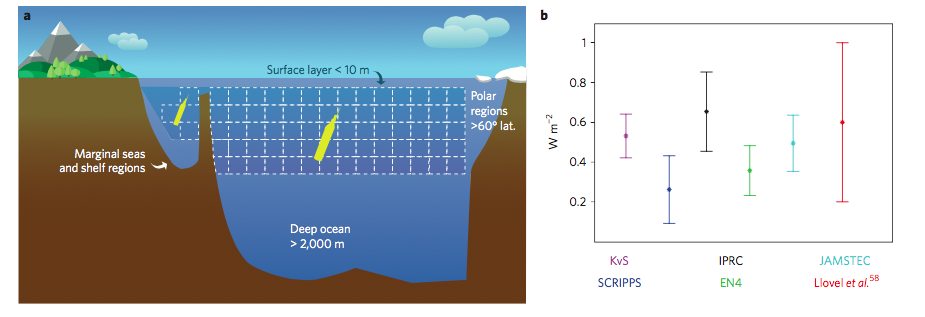Many skeptics of the case for climate action have fixated on the global warming hiatus of the early 21st century. Some have become so attached to the notion of a hiatus, that Congressional investigations still question how specific scientists choose to define a warming hiatus or lack thereof (even when they are analyzing the same dataset).
It’s clear why a warming hiatus—or prolonged slowdown—would cause one to question the predictions of climate models or the central estimates of climate sensitivity. If fossil fuel emissions have increased atmospheric CO2 by 10 percent since 1998, but temperatures have only creeped up, where is the warming? Is something wrong with global warming theory? Are climate models too sensitive to added CO2?
The problem with concluding that climate sensitivity is low (or that climate models are too sensitive to CO2) is that decade-to-decade changes in surface temperature are not good indicators of whether or not the earth system is accumulating excess heat or that the climate sensitivity is remarkably lower than previous expectations. There is too much ambiguity in any decade-to-decade trend to discursively say that continued CO2 emissions will result in more or less warming on century scales.
But a hiatus in the warming rate did happen, so where is the heat? It is likely in the oceans. Because the oceans have an enormous capacity to capture heat, they accumulate (most of) the excess heat when there is more solar radiation hitting the earth than is emitted by the atmosphere (the basic greenhouse effect). And over the hiatus period, winds in the tropical Pacific favored faster oceanic heat uptake.
This is important because global warming is really about the Earth’s energy imbalance (more heat entering than leaving). The diagram below shows what scientists estimate the heat budget of the climate system looked like in the modern era, with a radiative imbalance at the top of the atmosphere and heat going into the oceans (the green down arrow).
Heat Budget via Scientific American, numbers from IPCC AR5
However, measuring the Earth’s energy imbalance is not trivial. Studying the image above, the difference between incoming radiation and outgoing radiation is about 1 watt per meter squared (Wm-2) against an incoming 340 Wm-2 (or a few tenths of a percent). Note that the uncertainties in incoming and outgoing radiation are a few Wm-2, and the flows within the climate system are also large.
Earlier this year, a paper in Nature Climate Change by von Schuckmann and others, made the case that instead of focusing on temperature trends, we should focus on observing and understanding the Earth’s energy imbalance with greater accuracy and precision. This argument has been around for some time (from researchers across the spectrum of skepticism), because understanding the energy budget informs our understanding of individual processes that drive climate feedbacks (like what clouds do in a warming world) and measures of climate sensitivity.
The primary methods for observing the earth’s energy imbalance are observing the incoming and outgoing radiation from a satellite above the Earth, and by observing the rate of change of ocean heat content (since most excess heat is buried into the ocean). But in both cases, the signal-to-noise ratio can be large.
From a satellite, instruments can measure the net radiative imbalance at the top of the atmosphere by measuring incoming radiation from the sun and outgoing radiation from the Earth. While measurement errors are too large to capture the absolute signal of the radiative imbalance (c.f. The above diagram), it is possible to distinguish some information between decades. Using a combination of satellite and other data, this study found an average increase in radiative imbalance at the top of the atmosphere between 1985-1999 (0.34 ± 0.67 W m-2) and 2000-2012 (0.62 ± 0.43 W m-2)—indicating an increased radiative imbalance over the period of the hiatus than the 15 years before. But instrumental uncertainty and internal variability mean that this difference is exceeded by error in our monitoring technology.
In the ocean, instruments measure the temperature and salinity of seawater, but the chronic undersampling of the deep ocean and marginal seas means there is substantial error in heat content trend estimates. Despite the advances of the ARGO program—an array of robotic buoys that sample the ocean down to 2000 m around the world—estimates of heat uptake rate in the oceans are subject to uncertainties of nearly 50 percent. The following picture from von Schuckmann et al., shows five heat uptake rate estimates for the upper 2000 meters of the ocean, between 2005 and 2013. The red line results from hybrid approach that combines temperature data from the ARGO buoys and sea level data from satellites provides an estimate of full-depth ocean heat content changes of 0.64 ± 0.44 Wm-2 between 2005 and 2013.
Source: von Schuckmann et al. 2016
Von Schuckmann et al. argue that by improving the sampling of the ocean and maintaining and improving the satellite systems that measure the radiative imbalance at the top of the atmosphere, a tight accounting of the Earth’s energy imbalance between decades is within our grasp for the first time. A tight accounting would allow for detecting how the climate responds to increasing CO2 concentrations, without the ambiguities involved with monitoring and tracking temperature. But it would require investment in better and sustained climate monitoring technologies (if incorporated into climate policy, there is a strong cost-benefit case to support such investments).
That may be the best path forward for Congressional climate skeptics. If they are deeply worried about expensive climate policies (sorry conservatives, they are already here), because they think that CO2 will not strongly affect future climate, then demonstrating that limited effect is a requirement to set appropriate policy measures. Studying the energy balance won’t disprove the ‘CO2 hypothesis,’ but it could give us a far better grip on the uncertainties going forward.
Harping on temperature trends won’t cut it.

